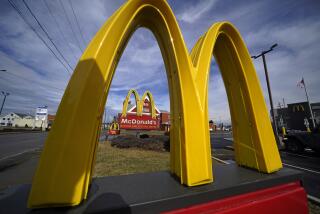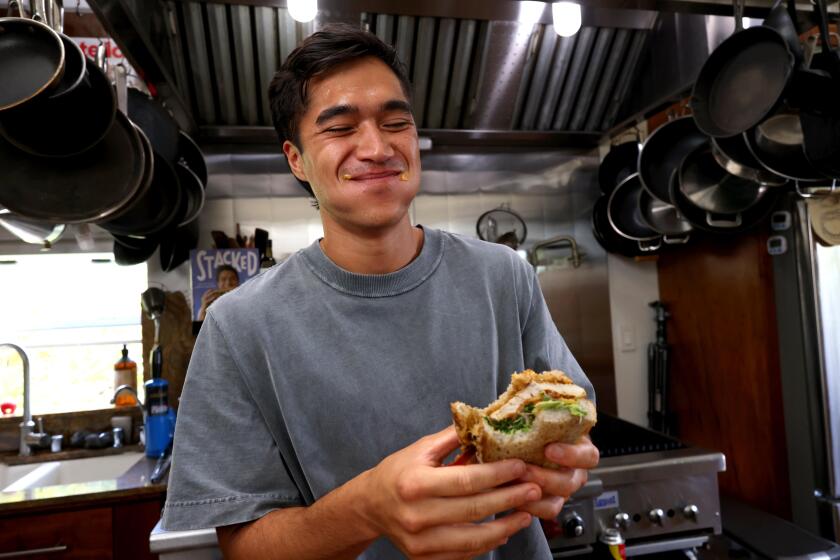Despite scare, L.A. still has an appetite for beef
Liz Gordon, 37, was one of several shoppers clustered around the meat counter at Gelsonâs in Century City on Monday, querying a butcher about the âmad cowâ issue. He told them, âEverything is under control.â
âI thought Iâd ask,â said Gordon, âas long as Iâm buying meat.â She walked away with a package of ground sirloin.
Victoria Kardon, 39, said she was concerned too. âBut I just bought New York steak.â
On Christmas Eve, Dr. Gregory Fontana, cardiac surgeon and chief of pediatric surgery at Cedars-Sinai Medical Center in Los Angeles, served a prime rib roast.
One of his guests had some concerns, he said, but once he explained the way the disease is transmitted --by neural tissue, not muscle meat --his guest was reassured. By the end of the evening, the nine diners had left only enough of the 16-pound roast for a couple of sandwiches.
And by Tuesday, Patrick Kirchen, manager of Arroyo Chop House in Pasadena, was breathing a sigh of relief.
âWeâve been pleasantly surprised,â he said. âWeâve been very busy since Christmas Eve. We were expecting maybe a little panic, but business has been above average. Our most popular cuts are actually bone-in cuts, a bone-in tenderloin and a bone-in rib-eye.â
Steady sales
All over town last week --at markets, restaurants and around holiday dinner tables --people were talking about âmad cow.â But often, it seemed, they worried, speculated and even jested in between bites of beef.
Los Angelesâ attitude mirrored that of the rest of the country. The cattle futures market and burger chain stocks had taken a hit after last weekâs announcement that the spinal material of a slaughtered Washington cow showed signs of bovine spongiform encephalophy (BSE), or what is more commonly known as âmad cowâ disease. But on Monday, the burger chains announced that their sales had been unaffected over the weekend, and their stock prices have partly recovered. Cattle futures have fallen almost 16% on the Chicago Mercantile Exchange since the news and the subsequent ban of imports of American beef by several countries.
Local markets reported steady beef sales. âOn Christmas Eve, when the story broke,â said Terry OâNeal, spokesman for Ralphs, âwe were getting questions. But we havenât seen the customer concern that we have during earlier food scares.â
Even the health-food chains said as much. Elizabeth Carovillano, marketing director for the Southern Pacific Region of Whole Foods Markets, said Whole Foods customers were âdefinitely questioning [the beef]. When we remind customers of our quality standards, they say, âOK, yes, I am reassured.â â
A shopper at the West Hollywood Bristol Farms Market, who declined to give her name, said, âIâm in total denial. Iâm not really concerned with buying beef. I donât eat that much beef anyway.â She said that if she were in a situation where beef was served, for example at a party, âI donât think it [the âmad cowâ issue] would make me hesitate.â
Still in demand
Premium meat suppliers reported no decline. âIt has no effect on us whatsoever,â said Harvey Gussman of Harveyâs Guss Meat Co., which supplies many restaurants and hotels. âOrders have not dropped.â
His customers, he said, âwant to know whatâs happening, but we donât handle that kind of merchandise. We donât use cow meat. âI bring in nothing but [Midwestern] beef. Even the chuck for grinding is from steers.â
And several restaurants reported a beef-oriented weekend.
âWe did not see any depletion in steak sales at all over the weekend,â Spago general manager Tracy Spillane said. âThe waiters didnât even report questions being asked. The people who were used to enjoying a steak have kept on ordering steak.â
On Saturday, the Valley Inn in Sherman Oaks was nearly full. Wes Idol, owner of Pacific Dining Car in Los Angeles, said, âPrime rib has been the top-selling item on our dinner menu this season.â
Said Piero Selvaggio of Valentino: âWe have heard nothing from our customers.â
On Friday, Govind Armstrong of Table 8 on Melrose was afraid customers would stay away from beef.
âI expect to see a decline in the Kobe-style flatiron steak,â he said then. âItâs our signature dish and our top seller. And also in the salt-roasted Angus porterhouse for two.â
But he was surprised to find no change.
âOn Saturday, there wasnât a single order for either in the first 7 or 8 tables, which is the first time Iâve seen that happen,â he reported Tuesday, âbut we finished the night selling as many as ever.â
Times staff writer S. Irene Virbila contributed to this report.
*
(BEGIN TEXT OF INFOBOX)
What you need to know
Times readers have asked various questions about âmad cowâ disease:
Do I need to throw out all the ground beef I have?
Safeway Inc., Kroger Co. and Albertsons Inc., which purchased beef from a plant that handled the infected cow, say none of it has reached their California markets. Twenty percent of the suspect meat apparently reached some small markets in California and five other states outside the Pacific Northwest, but the USDA is not divulging their names under legal counsel. If you bought your meat in a supermarket, at any rate, it did not come from the infected cow.
If I cook the living daylights out of it, will it make the beef safe to eat?
Cooking does not kill the infectious agent of âmad cowâ disease; infected meat has to be disposed of. If it were discovered that BSE-infected meat was being sold locally, the markets in question would be ordered to recall it and health authorities would advise you to dispose of it.
Does this mean that a fast-food cheeseburger can kill me?
Unlikely, and virtually impossible if the meat comes from animals who had grown up on vegetarian feed as, at this point, most are. BSE was spread by feed enriched with recycled cattle protein, a practice that was outlawed in 1997. Compliance with the law has been 99% since 1999. The danger is in meat from older animals, nearly always dairy cattle, because of their greater likelihood of exposure to tainted feed and because the disease takes several years to develop.
Though human variant Creutzfeldt-Jakob disease is invariably fatal, its rate of infectivity is low. In England, more than 200,000 BSE-infected cattle were sold for food from the 1970s through the 1990s, but so far 143 people have died of the disease there. The symptoms take several years to manifest, so new cases are appearing at a rate of 20 a year.
-- Charles Perry
More to Read
Eat your way across L.A.
Get our weekly Tasting Notes newsletter for reviews, news and more.
You may occasionally receive promotional content from the Los Angeles Times.










